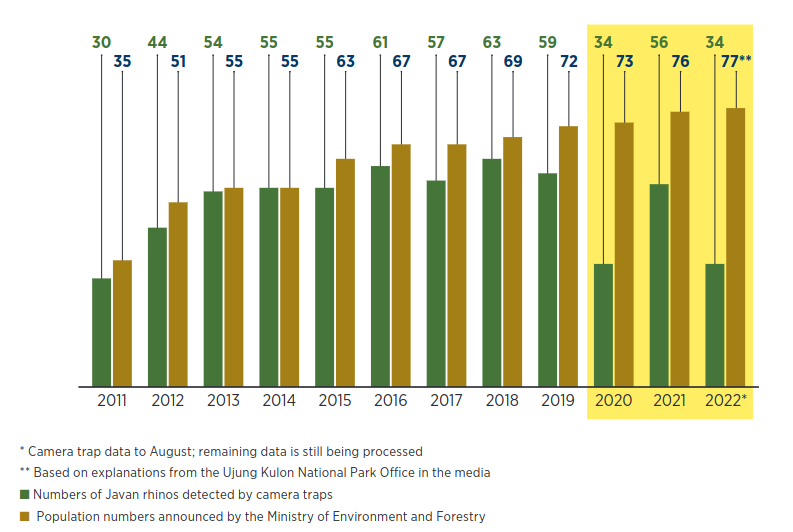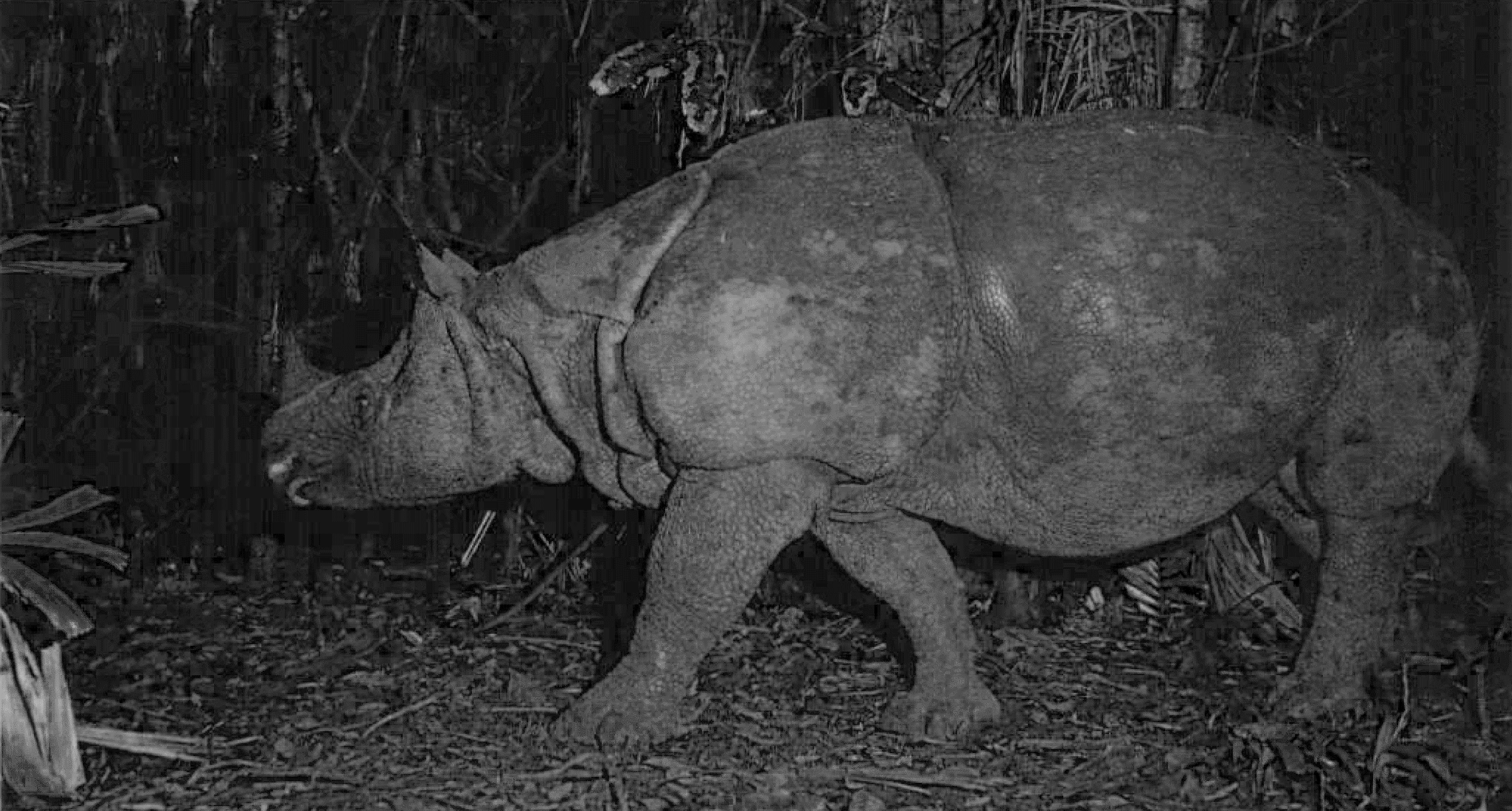Critical, Javan Rhinos Need Strategic Yet Effective Intervention
All parties should encourage the MoEF to immediately conduct a comprehensive evaluation of Javan rhino conservation efforts in Ujung Kulon National Park.
Jakarta, April 11 2023—Eighteen Javan rhinos (Rhinoceros sondaicus sondaicus) have disappeared in Ujung Kulon since 2019, and three of them have been found dead. Poaching of animals, including the Javan rhinoceros, seems to be running rampant in Ujung Kulon National Park, the only remaining habitat of the Javan rhino today.
Additionally, a series of Auriga Nusantara's investigative findings show that a crisis is befalling Javan rhinos in Ujung Kulon National Park. Not only the technical aspects of conservation have strayed, but also the institutional and budgeting of Ujung Kulon National Park that needs fundamental improvements. These findings include:
-
Indication of increased poaching in Ujung Kulon National Park
The extinction of Sumatran rhinos in Lampung have caused rhino poachers to come to Ujung Kulon, which is not too far from Lampung. The presence of (i) holes in the skull of a male Samson rhino who was found dead in 2018; (ii) snares designed for rhinos or at least large mammals; and the high number of illegal intruders, including armed poachers, are indicators of the increase in animal poaching in Ujung Kulon National Park.
Illegal activities recorded by camera traps in Javan rhino habitat inside Ujung Kulon National Park 2021–2022. It is apparent that people entering the park illegally have reached the entire rhino habitat area on the Ujung Kulon Peninsula to the west of JRSCA, with some of them even carrying rifles. The JRSCA area – which is also subject to illegal entry – is not part of the existing rhino habitat in Ujung Kulon National Park. | Source: Anonymous Whistleblowers
-
Indication of a falling Javan rhino population in Ujung Kulon
Since 2020, camera traps have only recorded less than 60 Javan rhinos in Ujung Kulon (whereas in 2018, 63 individuals were recorded). Although camera trap findings has decreased, the Ujung Kulon National Park Agency or the Ministry of Environment and Forestry announced that the population is always increasing. Likewise, for the absence of 18 rhino individuals since 2019, not a shred of information about this matter was announced to the public.Javan rhino population dynamics in Ujung Kulon National Park since 2011. Rhinos recorded by camera traps in Ujung Kulon vs population figures announced by the Ujung Kulon National Park Office or Ministry of Environment and Forestry: In the last four years, despite numbers recorded by camera traps always being lower than in 2018, the Ujung Kulon National Park Office or Ministry of Environment and Forestry consistently publicize figures suggesting the population is increasing. | Source: Anonymous Whistleblowers
-
A string of Javan rhino deaths has never been thoroughly investigated
Since 2012 there have been at least 11 Javan rhino deaths in Ujung Kulon National Park. However, only 3 were announced by the Ujung Kulon National Park Agency or the Ministry of Environment and Forestry. The high rate of unnatural mortality of Javan rhinos in Ujung Kulon National Park should be a serious concern. In February 1982, for example, there were 5 deaths of Javan rhinos suspected to be caused by anthrax. In 2010, there were 3 Javan rhino deaths in Ujung Kulon National Park where insects around the point of death contained the blood parasite Trypanosoma, a type of bacteria suspected to be the cause of death of 5 Sumatran rhinos in captivity in Malaysia in 18 days in 2003. The incomplete investigation of the cause of each of these deaths is a fatal mistake because it does not become a lesson learned to prevent the unnatural death of Javan rhinos.Known Javan rhino deaths in Ujung Kulon National Park since 2012. The large number of female and infant deaths should be a warning sign for the Javan rhino population in Ujung Kulon National Park | Source: Anonymous Whistleblowers

A male rhino named Manggala found dead in Ujung Kulon National Park in 2019. His position clearly indicates he did not die of old age. Looking at his size, as also analysed from camera images, this rhino was still a juvenile or infant. Source: KLHK (in Mongabay)
-
Management of Ujung Kulon National Park is on the wrong track
The budget allocation of Ujung Kulon National Park has not been prioritized for technical needs of rhino conservation currently. Meanwhile, the structure and placement of employees do not reflect the prioritization of technical rhino conservation activities. In recent years, the Ujung Kulon National Park Agency has spent their resources and energy on the construction of the Javan Rhino Study and Conservation Area (JRSCA), even though this area is outside the existing habitat of the Javan rhinoceros and is not needed for a second habitat or second population program.
Ujung Kulon National Park Office budget allocations, 2019–2022. Almost half of these budgets have been allocated for building the Javan Rhino Sanctuary and Conservation Area (JRSCA), yet the area in question is not an existing rhino habitat. | Source: Directorate General of Natural Resources and Ecosystem Conservation (Ditjen KSDAE) performance reports (2019, 2022) and KSDAE Statistics (2020, 2021).
The above findings should trigger a fundamental and thorough evaluation on species conservation in Ujung Kulon National Park. Therefore, we recommend these following steps:
- There should be an overall improvement in the protection of the Javan rhino and Ujung Kulon National Park.
- The security system that has prevailed until now should be thoroughly investigated to ascertain performance and at the same time identify where improvements should be made.
- Dialogues and consultations should be held with experts in park and species safeguarding to secure input and fresh ideas on how best to protect Javan rhinos and Ujung Kulon National Park.
- Maximize all existing potential, in terms of both social capital and technologies: Specifically in regard to technology, the Ujung Kulon National Park Office should fully utilize camera traps also identify who is entering rhino habitats illegally. Equipment such as CCTV cameras, and/or other technologies should be used to monitor park access points.
- The National Park Office and/or Ministry of Environment and Forestry should calculate the Javan rhino population in accordance with academic standards.The determination of calculation methodologies should be discussed academically and involve credible experts. This process should be led by a scientific authority, or conducted by involving a credible team of experts, and in an environment that supports academic freedom.
- Conduct a thorough evaluation of the Ujung Kulon National Park Office, looking at its institutional, budgetary, and programmatic arrangements.
- Restructure the Ujung Kulon National Park Office so it has units designated specifically to managing certain species, which can at the same time provide career incentives and wellbeing.
- Ensure budgets are dependent on prioritize conservation of the Javan rhino and other flagship species.
- In a consistent and continual manner – with the state budget conduct collaboratively-formulated Javan rhino conservation activities, especially (i) population management, (ii) habitat management, (iii) protection, and (iv) Javan rhino co-existence with local communities.
- Build an atmosphere conducive to the involvement of and support from conservationists.
- Implement a Javan rhino second population or second habitat programme in earnest, which, in order, should involve the following: (1) designating second population areas; (2) developing temporary facilities – like JRSCA – in those designated areas; (3) selecting individual Javan rhinos in UKNP to be moved; (4) translocating the selected Javan rhinos to temporary facilities in the destination habitats; (5) analysing and habituating the Javan rhinos in temporary facilities, until (6) releasing them in stages into the surrounding forest; and (7) monitoring their populations in the new habitats
- Encourage and open up space for research into Javan rhinos, including research into potential diseases, and forensic investigations into every unnatural Javan rhino death..
Further information about the above findings and recommendations can be accessed in the report entitled Javan Rhinoceros in Jeopardy: Conservation Setbacks in Ujung Kulon which was released through a press conference on Auriga Nusantara's YouTube channel.
Contact person:
Riszki Is Hardianto (Auriga Nusantara): riszkiis@auriga.or.id

